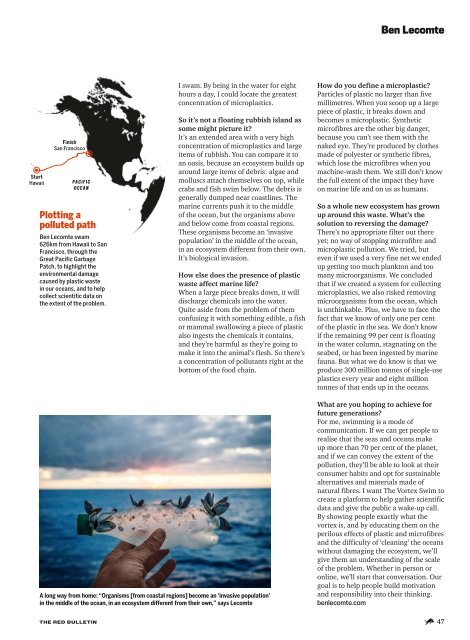Create successful ePaper yourself
Turn your PDF publications into a flip-book with our unique Google optimized e-Paper software.
Ben Lecomte<br />
Start<br />
Hawaii<br />
Finish<br />
San Francisco<br />
PACIFIC<br />
OCEAN<br />
Plotting a<br />
polluted path<br />
Ben Lecomte swam<br />
626km from Hawaii to San<br />
Francisco, through the<br />
Great Pacific Garbage<br />
Patch, to highlight the<br />
environmental damage<br />
caused by plastic waste<br />
in our oceans, and to help<br />
collect scientific data on<br />
the extent of the problem.<br />
I swam. By being in the water for eight<br />
hours a day, I could locate the greatest<br />
concentration of microplastics.<br />
So it’s not a floating rubbish island as<br />
some might picture it?<br />
It’s an extended area with a very high<br />
concentration of microplastics and large<br />
items of rubbish. You can compare it to<br />
an oasis, because an ecosystem builds up<br />
around large items of debris: algae and<br />
molluscs attach themselves on top, while<br />
crabs and fish swim below. <strong>The</strong> debris is<br />
generally dumped near coastlines. <strong>The</strong><br />
marine currents push it to the middle<br />
of the ocean, but the organisms above<br />
and below come from coastal regions.<br />
<strong>The</strong>se organisms become an ‘invasive<br />
population’ in the middle of the ocean,<br />
in an ecosystem different from their own.<br />
It’s biological invasion.<br />
How else does the presence of plastic<br />
waste affect marine life?<br />
When a large piece breaks down, it will<br />
discharge chemicals into the water.<br />
Quite aside from the problem of them<br />
confusing it with something edible, a fish<br />
or mammal swallowing a piece of plastic<br />
also ingests the chemicals it contains,<br />
and they’re harmful as they’re going to<br />
make it into the animal’s flesh. So there’s<br />
a concentration of pollutants right at the<br />
bottom of the food chain.<br />
How do you define a microplastic?<br />
Particles of plastic no larger than five<br />
millimetres. When you scoop up a large<br />
piece of plastic, it breaks down and<br />
becomes a microplastic. Synthetic<br />
microfibres are the other big danger,<br />
because you can’t see them with the<br />
naked eye. <strong>The</strong>y’re produced by clothes<br />
made of polyester or synthetic fibres,<br />
which lose the microfibres when you<br />
machine-wash them. We still don’t know<br />
the full extent of the impact they have<br />
on marine life and on us as humans.<br />
So a whole new ecosystem has grown<br />
up around this waste. What’s the<br />
solution to reversing the damage?<br />
<strong>The</strong>re’s no appropriate filter out there<br />
yet; no way of stopping microfibre and<br />
microplastic pollution. We tried, but<br />
even if we used a very fine net we ended<br />
up getting too much plankton and too<br />
many microorganisms. We concluded<br />
that if we created a system for collecting<br />
microplastics, we also risked removing<br />
microorganisms from the ocean, which<br />
is unthinkable. Plus, we have to face the<br />
fact that we know of only one per cent<br />
of the plastic in the sea. We don’t know<br />
if the remaining 99 per cent is floating<br />
in the water column, stagnating on the<br />
seabed, or has been ingested by marine<br />
fauna. But what we do know is that we<br />
produce 300 million tonnes of single-use<br />
plastics every year and eight million<br />
tonnes of that ends up in the oceans.<br />
A long way from home: “Organisms [from coastal regions] become an ‘invasive population’<br />
in the middle of the ocean, in an ecosystem different from their own,” says Lecomte<br />
What are you hoping to achieve for<br />
future generations?<br />
For me, swimming is a mode of<br />
communication. If we can get people to<br />
realise that the seas and oceans make<br />
up more than 70 per cent of the planet,<br />
and if we can convey the extent of the<br />
pollution, they’ll be able to look at their<br />
consumer habits and opt for sustainable<br />
alternatives and materials made of<br />
natural fibres. I want <strong>The</strong> Vortex Swim to<br />
create a platform to help gather scientific<br />
data and give the public a wake-up call.<br />
By showing people exactly what the<br />
vortex is, and by educating them on the<br />
perilous effects of plastic and microfibres<br />
and the difficulty of ‘cleaning’ the oceans<br />
without damaging the ecosystem, we’ll<br />
give them an understanding of the scale<br />
of the problem. Whether in person or<br />
online, we’ll start that conversation. Our<br />
goal is to help people build motivation<br />
and responsibility into their thinking.<br />
benlecomte.com<br />
THE RED BULLETIN 47

















